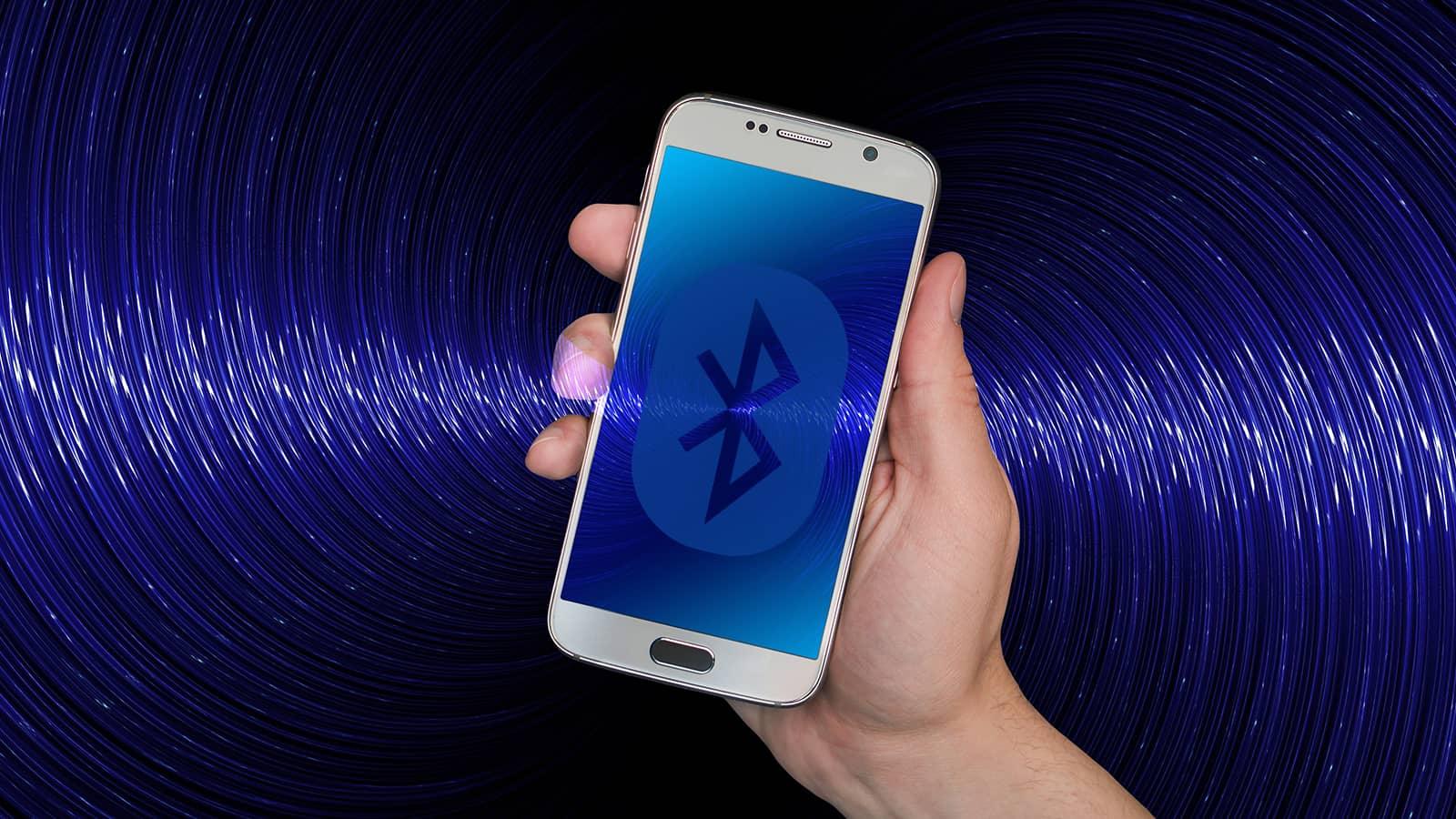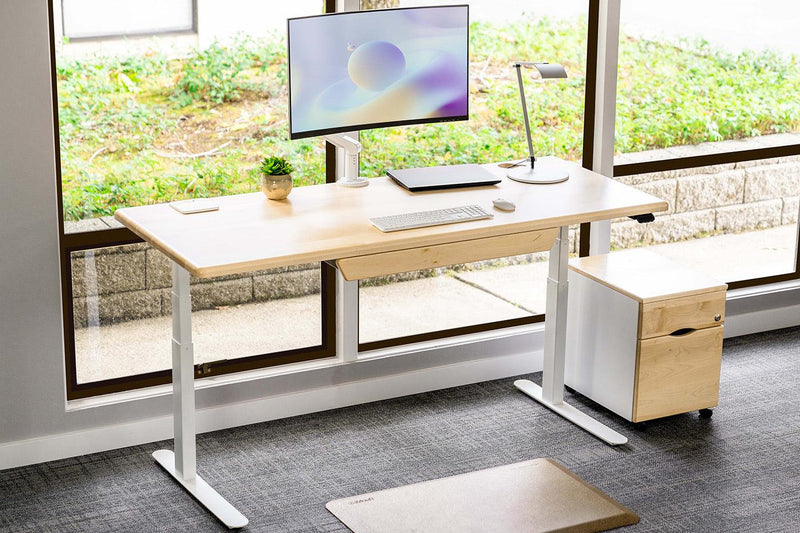Just as with the EV (electric vehicle) revolution, when standing desks went from manual crank handles to being driven by electric motors over the past decade this created the opportunity for adding many more advanced features to what used to be a very simple piece of furniture. Of course first and foremost we saw the advent of programmable digital controllers, with LED height readouts and the ability to store two to four "height favorites" in the handset.
Next, we saw the addition of collision detection and tilt detection for protecting the desk and its contents from accidental damage, as well as prevent accidental injury to small children and pets who might get caught under the desk during a height transition.
Just as EVs got large touchscreen dashboards as part of the upgrade from gas to electric, the addition of Bluetooth circuitry to stand-up desks is analogous to the promise of eventual fully-autonomous autopilot for electric vehicles.
No, we don’t mean you’ll be driving down the highway on your desk’s caster wheels while getting your work done. But the advent of smartphone apps for standing desks is shepherding in an entirely new set of features that may feel like science fiction being brought to life.
Things you can already do with Bluetooth and smartphone apps for your standing desk
All smartphone apps for standing desks today feature remote control of the desk itself. What’s so great about controlling your desk from your phone? At the most rudimentary level, it means your preferred height settings are your own, not intermingled with other users of the same desk. And you can sync with more than one desk; perhaps one at the corporate office, one at your home office, and others when you travel through airports, hotels and co-working spaces.
For shared workstations, the sad fact is that programmable height memories almost always go unused. Why? Because as soon as your personal settings are overwritten by the next user they are useless to you, and you’ll quickly tire of the exercise in futility. The only time they really work well is when there are no more than two users sharing the same desk and there are four memories—two of them dedicated for each user. This works well for a husband and wife sharing a home office standing desk, for example.
When you switch to using your smartphone to set your height preferences, your personal settings reside in your phone rather than in the desk’s handset controller. They won’t get inadvertently erased if the desk momentarily loses power. Most apps allow for four to six height favorites for each user.
With smartphone control, there’s no limit as to how many users can share a workstation. There’s also no limit on how many workstations a single individual can use. Any compatible desk they walk up to will instantly re-learn their personal settings over the Bluetooth sync.
Going along with your height settings are your personal usage statistics. This is important for apps that have built-in "health coach" features, which are basically notifications that remind you to change positions at intervals that you specified, in accordance with your personal health goals.
In case you’re wondering whether this is a useful feature or just a gimmick, note that a study conducted in Denmark with iMovR’s Lander Desk showed a 117% increase in standing desk usage at standing height simply from the addition of the health coaching feature. If you’re not familiar with it, the coach pushes notifications to the multi-color display in the desks controller and/or to the user’s smartphone to unobtrusively prompt the user to change position, without breaking their work flow.
An automatic benefit of controlling desks from smartphones that has been touted ever since the pandemic is the concept of "touchless controls." Meaning that the risk of contracting a nasty germ like norovirus from contact with an infected surface goes away if you never again touch the same controller pad as previous users, but rather control your desk from your phone instead. Since germs like Norovirus aren’t killed as easily as COVID with the simple swipe of a Lysol wipe, this isn’t as inconsequential as it might sound.
Other things you’ll soon be able to do with Bluetooth and smartphone apps on your standing desk
As an ergonomics workstation manufacturer, iMovR currently has no fewer than eight Bluetooth-enabled accessories for standing desks in development or already on the market. These devices include the desks themselves, of course. By the end of 2021 iMovR will have incorporated Bluetooth into every single one of our standing desk products.
In the near future we’ll be releasing several other Bluetooth-enabled devices that will be controllable from the same iMovR Ergodynamics smartphone app. One tap will change your desk height, monitor height (with our upcoming Emma electric monitor arm), and even set your preferred walking speed in one coordinated move, for example.
iMovR will also be releasing (patented) sensors that will work with all makes and models of standing desks and office treadmills, to bring the same kind of usage data into the app as our Bluetooth-enabled products do natively. These plug-and-play sensors will not require any installation; they will just need to be synced up with your smartphone and registered to a specific physical workstation ID number or location.
Future integrations you can expect include interoperability with all popular wearable devices so that you can get accurate feeds into your health tracking apps for time spent standing or walking at your desk. You’ll also see interoperability with corporate wellness software platforms that will allow companies to generate anonymized reports on how well their own employee population is benefitting from the conversion to active workstations, in terms of both productivity and health. And regardless of whether employees work on campus, from a home office, or hybrid remote.
iMovR has blazed the Bluetooth trail for active workstations
We’ve been pioneering the incorporation of Bluetooth synchronization between standing desks and users’ smartphones longer than any other deskmaker, starting back with the launch of our flagship Lander Desk in April of 2018. This was followed up by the introduction of the Lander Lite in 2019, the ZipDesk in 2020, and more new desks launching in upcoming years. In fact, with the launch of the Jaxson Desk line in 2022, we’re committed to updating all of our standing desk models to include Bluetooth, ahead of any other manufacturer.
Unsurprisingly we’re starting to see a few Chinese competitors introduce Bluetooth sync for a standing desk here and there, albeit with unsophisticated and unstable apps. To be sure, Bluetooth connection integrity is a very challenging technical problem in an environment where multiple desks and users are within BLE (Bluetooth Low Energy) signal range of each other. Indeed most of the apps we’ve seen our competitors introduce utterly fail in a multi-desk environment due to insufficient testing and engineering.
Just as the automotive industry is aiming for a day when there will no longer be any more fossil fuel cars produced, we believe there will come a time when electric standing desks without Bluetooth will no longer be made. iMovR is happy to lead that charge by being the first to enable all of our active workstations with Bluetooth capability by the end of this year, and by continuing to develop integrations with more peripheral devices, health tracking apps and wearables, and corporate wellness software platforms.





